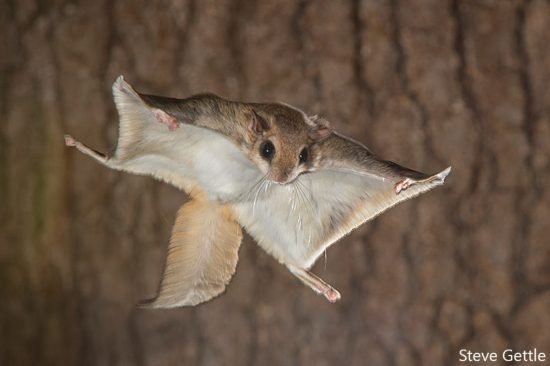
You see, flying squirrels aren’t actually flying in the way birds do. They glide, using a special membrane that stretches from their wrists to their ankles. This unique adaptation allows them to travel long distances between trees without touching the ground, which keeps them safe from predators and helps them find food. Let’s take a deeper look at how these remarkable creatures survive in the wild.
Adapting to Different Climates
Flying squirrels can be found in various habitats, including forests, woodlands, and even urban areas. They are native to regions across North America and parts of Asia, which means they must adapt to different climates. Whether it’s the cold, snowy winters of Canada or the humid conditions in the southern United States, flying squirrels have some clever tricks up their sleeves.
During harsh winters, these squirrels enter a state called *torpor*—similar to hibernation. They slow down their metabolism, which helps them conserve energy. With energy being a precious resource, this clever adjustment is essential. When the temperatures drop, they bundle up in tree cavities or make nests in tree hollows to keep warm and stay safe from predators.
Feeding Strategies
Flying squirrels are primarily nocturnal, meaning they are active at night. They rely on their keen sense of smell and excellent eyesight to forage for food in the dark. Their diet mainly consists of fruits, nuts, and fungi, which are available in various environments. Honestly, they have to be resourceful when food is hard to come by.
In winter, many of the trees lose their leaves, making food scarce. To prepare for these lean months, flying squirrels gather and store food in tree cavities or hidden spots. They’ve got an incredible memory, as they can find these hidden treasures months later, even under a layer of snow! This behavior highlights their adaptability and planning skills, which are crucial for survival.
Building Cozy Homes
Have you ever thought about where flying squirrels sleep? Their homes play a significant role in their survival. Instead of building nests like some other animals, they prefer to take advantage of existing tree cavities. This is a smart move, especially during harsh weather.
Keeping warm is key during cold months. Tree cavities provide shelter from wind and rain, allowing flying squirrels to stay cozy. Some even share these spaces with other squirrels, creating a communal atmosphere that enhances their chances of survival. By huddling together, they can conserve body heat, much like how we bundle up with blankets during a chilly night.
Staying Safe from Predators
Predators are always lurking, and flying squirrels must be aware of their surroundings. With their nocturnal habits, they avoid many daytime hunters. However, they still face threats from owls, hawks, and even domestic cats. To evade these predators, flying squirrels depend on their incredible gliding ability.
When they sense danger, they take a leap from a high branch and glide silently through the air, landing on another tree. They can change direction mid-air, which makes it hard for predators to catch them. Honestly, it’s a bit like a parkour move—quick, agile, and impressive!
Dealing with Urban Challenges
As humans expand their cities and markets, flying squirrels have adapted to urban environments. They often find refuge in parks, larger gardens, and even backyards. These urban squirrels face different challenges, such as traffic and habitat loss, but they’re resilient.
In cities, food availability can be inconsistent. Luckily, they’ve learned to scavenge from humans, taking advantage of bird feeders and discarded snacks. This adaptability shows just how clever these creatures can be. While they thrive in the wild, their ability to adjust to human environments speaks volumes about their resourcefulness.
Bridging Habitats
Connecting green spaces is crucial for flying squirrels, especially in urban settings. Without adequate pathways between trees and parks, their chances of survival decrease. This is where human involvement can make a difference. Planting native trees and creating wildlife corridors can help them safely navigate their environment.
Building bridges of greenery not only supports flying squirrels but also biodiversity as a whole. When we preserve their habitats, we help maintain a balanced ecosystem where these charming gliders can flourish.
The Importance of Conservation
Understanding flying squirrels’ survival strategies highlights the need for conservation efforts. The loss of forests due to urban development and logging threatens their populations. Protecting their habitats ensures that flying squirrels can continue to thrive in both rural and urban settings.
Also, raising awareness about these unique creatures encourages people to appreciate their role in the ecosystem. Flying squirrels help disperse seeds and fungi, contributing to forest regeneration. So, by conserving their environments, we’re not just helping flying squirrels but fostering a healthier planet overall.
Community Involvement
Engaging communities in conservation projects is vital. Local initiatives can educate people about flying squirrels and their habitats. Organizing tree-planting events or workshops on creating wildlife-friendly gardens encourages folks to get involved. Plus, it’s a fun way to learn about nature!
When communities understand the challenges flying squirrels face, they become motivated to help. These efforts can lead to significant improvements for both the squirrels and local ecosystems.
Flying squirrels are a testament to nature’s incredible adaptability. From their unique gliding abilities to their clever feeding and nesting strategies, these creatures show us that survival often relies on being resourceful and adaptable. As we face environmental challenges, it’s crucial to appreciate and protect flying squirrels and their habitats.
So, the next time you hear the rustle of leaves at night, remember that it could be a flying squirrel gliding gracefully through the air. Let’s do our part to ensure they continue to thrive, because their survival is a reflection of the health of our environment. Every little effort counts, and together, we can create a world where flying squirrels and many other species can flourish.
